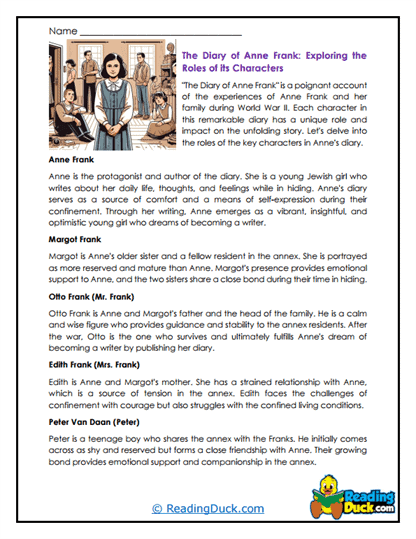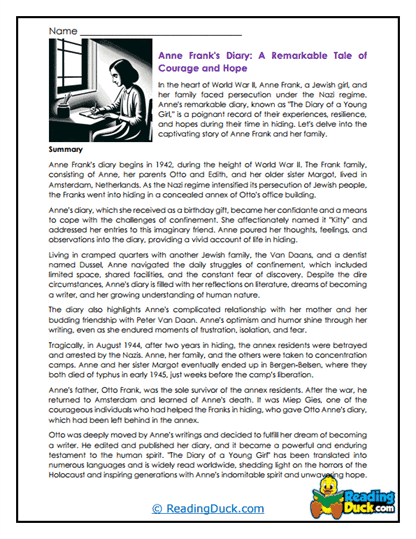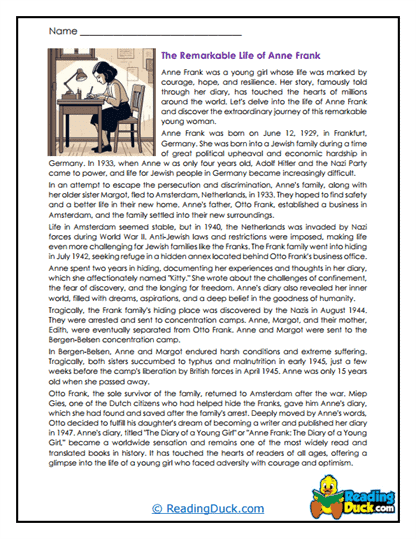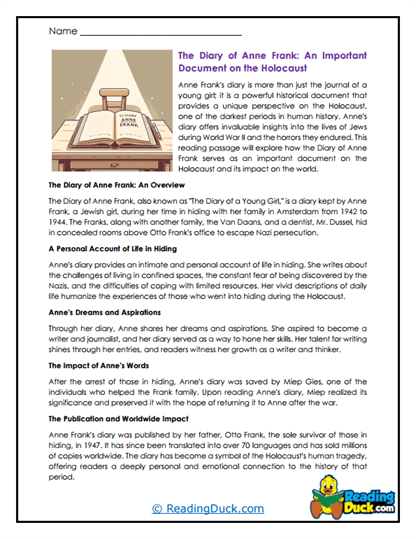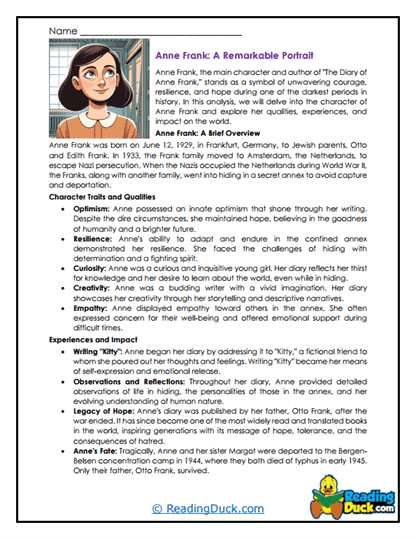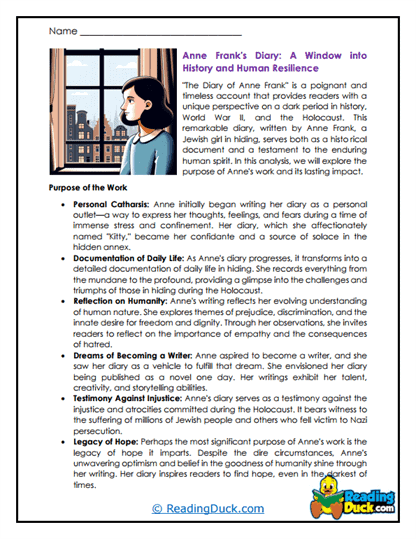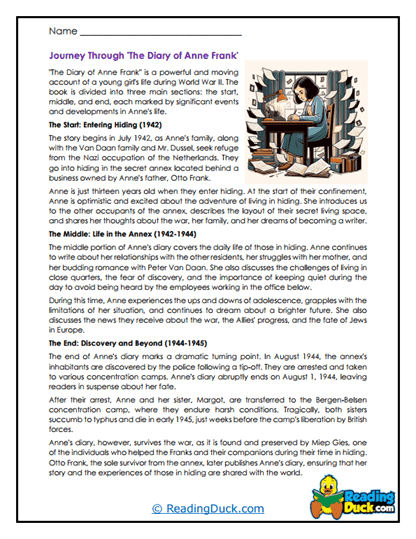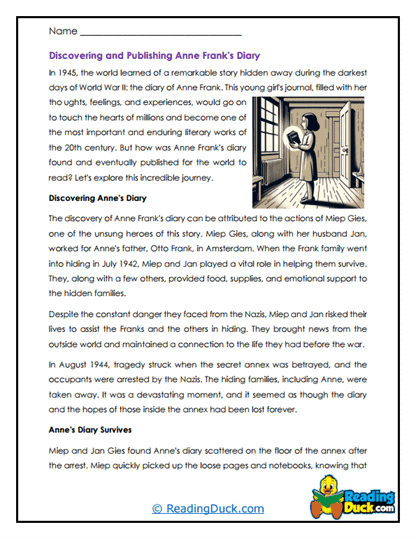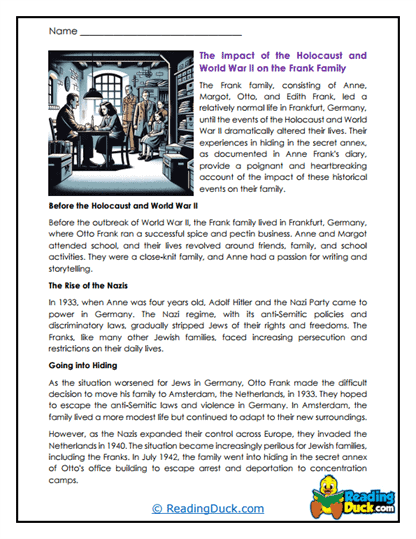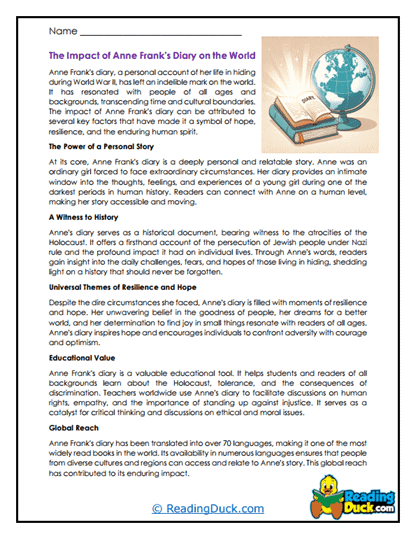The Diary of Anne Frank Worksheets
About Our The Diary of Anne Frank Worksheets
Our The Diary of Anne Frank worksheets provide a profound and engaging exploration of one of the most poignant and important personal accounts of the Holocaust. These worksheets are crafted to help students delve into the historical, emotional, and literary significance of Anne Frank's diary, offering a meaningful way to connect with this powerful text. They are designed to encourage critical thinking, empathy, and a deeper understanding of the themes and experiences detailed in the diary.
The Literature category that includes The Diary of Anne Frank also covers a wide range of other notable and classical works, such as 1984, Fahrenheit 451, Lord of the Flies, Of Mice and Men, Pride and Prejudice, Romeo and Juliet, The Great Gatsby, The Scarlet Letter, and To Kill a Mockingbird. Each collection is meticulously organized to provide a comprehensive study of one literary work at a time, ensuring that students gain a deep understanding of key themes, character dynamics, and the broader societal implications of these texts.
Each category features several worksheet sets, each focusing on different aspects of the literary work. For The Diary of Anne Frank, these worksheet sets include:
- Multiple Choice Questions: These questions help students grasp the basic events, characters, and themes in Anne Frank’s diary. By answering these questions, students can demonstrate their comprehension of the text and identify key elements that are crucial for understanding Anne's experiences and reflections.
- Short Answer Questions: This format encourages students to delve deeper into the text, allowing them to analyze specific entries, themes, and the historical context in their own words. These questions challenge students to think critically about the diary and articulate their interpretations and insights clearly.
- Open-Ended Questions: These questions invite students to reflect on their personal thoughts, opinions, and feelings about the diary. By engaging with the material on a personal level, students can develop a stronger connection to the text and enhance their ability to articulate their ideas and emotions.
Each worksheet set is designed to assess students’ understanding of the material while encouraging them to engage deeply with the text. An answer key is provided for every question sheet, ensuring that educators can easily assess student progress. All worksheets are available as PDF files, which can be easily viewed electronically, downloaded, and printed.
Understanding The Diary of Anne Frank: A Window into History and Humanity
When introducing The Diary of Anne Frank to students, it is important to emphasize that this text is more than just a historical document; it is a deeply personal account that brings to life the human experiences behind the atrocities of the Holocaust. Through Anne Frank’s words, students gain insight into the resilience of the human spirit, the horrors of war, and the importance of remembering and learning from the past.
Key Aspects of The Diary of Anne Frank to Understand:
- Life in Hiding: One of the central aspects of The Diary of Anne Frank is the detailed account of Anne and her family’s life in hiding. For over two years, Anne, her family, and four others lived in the “Secret Annex,” a hidden section of a building in Amsterdam. The diary captures the daily struggles, fears, and moments of hope that defined their existence in confinement. Students can explore the psychological and emotional impact of living under constant threat, and how this experience shaped Anne’s reflections and writings.
- Coming of Age in Adversity: Anne Frank’s diary is also a coming-of-age story. Written between the ages of 13 and 15, the diary chronicles Anne’s transition from childhood to adolescence under extraordinary circumstances. Her reflections on identity, relationships, and the future offer a poignant look at how young people navigate the complexities of growing up, even in the most challenging environments. This aspect of the diary allows students to connect with Anne on a personal level, recognizing the universal aspects of her experiences.
- The Impact of War and Persecution: The diary provides a powerful first-person perspective on the impact of World War II and the Holocaust on Jewish families in Europe. Anne’s writings convey the fear, uncertainty, and isolation felt by those persecuted under Nazi rule. Through her words, students can gain a deeper understanding of the human cost of war and the consequences of hatred and intolerance. This aspect of the diary serves as a vital tool for teaching about the Holocaust and the importance of standing against discrimination and injustice.
- Hope and Resilience: Despite the dire circumstances, Anne Frank’s diary is filled with moments of hope, resilience, and a deep belief in the goodness of humanity. Anne’s optimism, curiosity, and determination to make the most of her situation are recurring themes in her writing. This aspect of the diary can inspire students to reflect on the power of hope and the human capacity for resilience in the face of adversity.
- The Power of Writing: The Diary of Anne Frank is a testament to the power of writing as a means of coping, understanding, and preserving one’s voice. Anne used her diary as a way to process her experiences, express her thoughts and feelings, and maintain a sense of agency in a situation where she had little control. Students can explore how writing can serve as a tool for self-expression, reflection, and historical documentation.
By exploring these themes and aspects of The Diary of Anne Frank, students can gain a deeper understanding of the text and its significance. The diary challenges readers to think critically about history, human nature, and the importance of empathy and remembrance.
Impact and Legacy of The Diary of Anne Frank
The Diary of Anne Frank has had a profound impact on literature, history, and education since its publication in 1947. The diary’s intimate portrayal of a young girl’s life during the Holocaust has resonated with millions of readers around the world, making it one of the most influential and widely read accounts of the Holocaust.
Socio-Cultural History:
- Historical Context: The Diary of Anne Frank provides an invaluable firsthand account of life during the Holocaust, a period of immense suffering and persecution for Jews in Europe. The diary offers insights into the daily realities of those who lived in hiding, the fear of discovery, and the impact of anti-Semitic policies. Anne’s writings serve as a powerful reminder of the atrocities committed during this dark chapter in history and underscore the importance of educating future generations about the Holocaust to prevent such events from happening again.
- Publication and Reception: After the war, Anne’s father, Otto Frank, the only surviving member of the family, decided to fulfill Anne’s wish to become a published author by sharing her diary with the world. Since its publication, the diary has been translated into more than 70 languages and has become a key text in Holocaust education. Its widespread impact has helped to humanize the victims of the Holocaust, providing a personal and relatable account that goes beyond statistics and historical facts.
Cultural Impact:
- Educational Influence: The Diary of Anne Frank has become an essential part of literature and history curricula around the world. The diary is often used to introduce students to the Holocaust, providing a personal and accessible entry point into discussions about war, persecution, and the consequences of intolerance. The diary’s universal themes of hope, resilience, and the human experience make it a powerful tool for teaching about empathy, ethics, and the importance of standing up against injustice.
- Adaptations and Interpretations: The diary has been adapted into various plays, films, and documentaries, each bringing Anne’s story to new audiences. These adaptations have helped to keep Anne’s story alive for generations, ensuring that her voice continues to be heard. The diary’s adaptability also highlights its timeless relevance, as it speaks to the experiences of young people and the challenges of growing up in difficult times.
- Relevance Today: In a world where issues of intolerance, discrimination, and human rights are still pressing concerns, The Diary of Anne Frank remains a deeply relevant text. The diary’s exploration of the consequences of hatred and the importance of compassion and understanding resonates with modern audiences. It serves as a powerful reminder of the need to learn from history and to work towards a more just and inclusive world.
Enduring Legacy:
The Diary of Anne Frank is more than just a historical document; it is a powerful exploration of the human spirit, resilience, and the importance of remembering the past. Its themes continue to resonate today, making it a vital tool for understanding the complexities of history and the human experience. The diary’s legacy is evident in its continued popularity, its influence on education and culture, and its role in promoting tolerance, empathy, and the fight against hatred.
Encouraging Students to Appreciate Literature
As educators, one of our most important tasks is to help students develop an appreciation for literature. Literature opens up new worlds, perspectives, and ideas, helping students develop empathy, critical thinking skills, and a deeper understanding of the human experience. Here are some tips on how teachers and parents can use these The Diary of Anne Frank worksheets to encourage students to engage more deeply with literature:
Using Worksheets Effectively:
- Facilitate Reflective Discussions: After students complete the worksheets, encourage them to discuss their answers and interpretations of the text. The open-ended questions are particularly effective for sparking thoughtful discussions about the diary’s themes, Anne’s experiences, and the historical context. By engaging in these discussions, students can gain new insights and deepen their understanding of the text.
- Draw Connections to Real Life: Help students connect the themes of The Diary of Anne Frank to real-world situations. Discuss how the diary’s exploration of persecution, resilience, and hope relates to current events, historical examples, or personal experiences. This approach can help students see the relevance of literature in understanding the world around them.
- Encourage Creative Expression: Motivate students to engage with the diary creatively. They might write a letter to Anne, create a visual timeline of her life, or produce a short film that explores one of the key themes in the diary. These creative projects allow students to express their understanding of the text in unique and personal ways, making the literature more tangible and impactful.
- Incorporate Group Work: Use the worksheets as a basis for group activities. Students can work together to answer questions, analyze Anne’s character development, or role-play scenes from the diary. Group work encourages collaboration and allows students to learn from each other’s perspectives and interpretations.
- Foster Personal Reflections: Encourage students to keep a reading journal where they can reflect on their thoughts and feelings about the diary. The open-ended questions from the worksheets can serve as prompts for these reflections, helping students connect personally with the material and develop a deeper appreciation for the themes explored in The Diary of Anne Frank.
Creating a Literary Environment:
- Build a Classroom Library: Stock your classroom or homeschool environment with a variety of books, including other works about the Holocaust, such as Night by Elie Wiesel or Maus by Art Spiegelman. This encourages students to explore beyond the assigned reading and discover new authors and genres that deepen their understanding of history and human rights.
- Holocaust Study: Consider doing a broader study on the Holocaust, incorporating other texts, documentaries, and survivor testimonies. This can provide students with a broader context for understanding The Diary of Anne Frank and appreciating the importance of Holocaust education in preventing future atrocities.
- Host Literature Circles: Organize literature circles where students can discuss the diary in small groups. Assign each group a specific aspect of the diary to focus on, such as Anne’s reflections on identity, the psychological effects of hiding, or the historical context. This allows students to delve deeper into the text and share their insights with their peers.
By using these strategies, teachers and parents can help students develop a deeper appreciation for literature and inspire a lifelong love of reading. The Diary of Anne Frank worksheets are a valuable tool in this process, providing a structured yet flexible way to explore one of the most important and moving personal accounts of the Holocaust. Through these activities, students will not only understand the content of The Diary of Anne Frank but also connect with its themes and messages on a personal level, enriching their educational experience.
